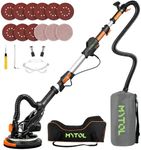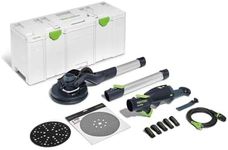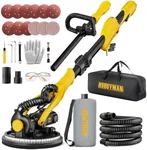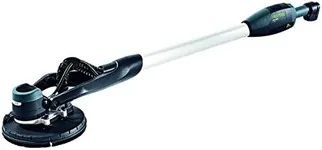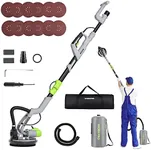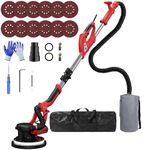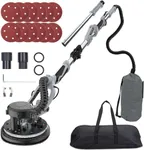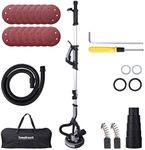Buying Guide for the Best Electric Drywall Sanders
Choosing the right electric drywall sander can make your sanding tasks much easier and more efficient. The right model for you will depend on the specific needs of your projects, such as the size of the area you need to sand, the type of surfaces you are working on, and your own comfort and experience level. Understanding the key specifications of electric drywall sanders will help you make an informed decision and ensure you get the best tool for your needs.Power (Wattage)Power, measured in watts, determines how strong and efficient the sander is. Higher wattage means more power, which can make sanding faster and more effective, especially on tougher surfaces. For light, occasional use, a sander with lower wattage (around 500-600 watts) may suffice. For more frequent or heavy-duty use, look for a sander with higher wattage (700 watts or more). Consider your typical projects: if you often work on large or rough surfaces, a more powerful sander will save you time and effort.
Speed (RPM)Speed, measured in revolutions per minute (RPM), indicates how fast the sanding head spins. Variable speed settings are important because they allow you to adjust the speed based on the material and the level of finish you need. Lower speeds (around 600-1000 RPM) are suitable for delicate surfaces or fine finishing, while higher speeds (up to 2000 RPM or more) are better for removing material quickly. Choose a sander with adjustable speed settings to give you flexibility for different tasks.
WeightThe weight of the sander affects how easy it is to handle, especially for extended periods. Lighter sanders (around 5-7 pounds) are easier to maneuver and less tiring to use, making them ideal for overhead or vertical sanding. Heavier models (8 pounds or more) might offer more stability and power but can be more challenging to use for long durations. Consider your physical strength and the nature of your projects when choosing the weight of your sander.
Dust CollectionDust collection is crucial for maintaining a clean work environment and protecting your health. Many electric drywall sanders come with built-in dust collection systems, which can include a vacuum attachment or a dust bag. A good dust collection system will minimize the amount of dust released into the air, making cleanup easier and reducing respiratory risks. Look for models with efficient dust collection features, especially if you are working indoors or in confined spaces.
Sanding Pad SizeThe size of the sanding pad determines the area you can cover in one pass. Larger pads (9 inches or more) can cover more surface area quickly, making them ideal for large walls or ceilings. Smaller pads (around 7 inches) offer more precision and are better for detailed work or smaller areas. Consider the typical size of your projects: if you often work on large surfaces, a larger pad will be more efficient, while a smaller pad is better for detailed or intricate work.
Handle DesignThe design of the handle affects comfort and control. Ergonomic handles with adjustable lengths and angles can reduce strain and make the sander easier to use, especially for extended periods. Some models also feature additional grips or handles for better control. If you plan to use the sander for long periods or on various surfaces, look for a model with a comfortable, adjustable handle to reduce fatigue and improve precision.


